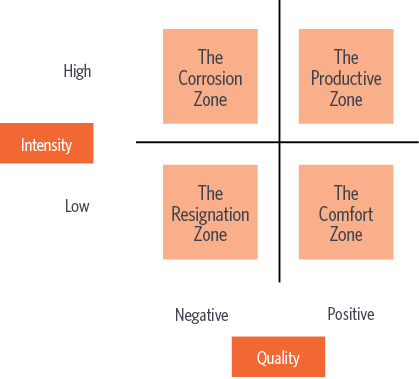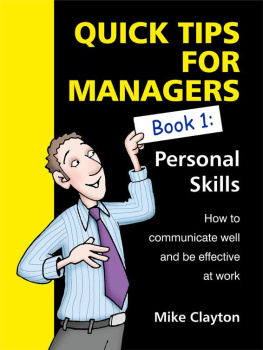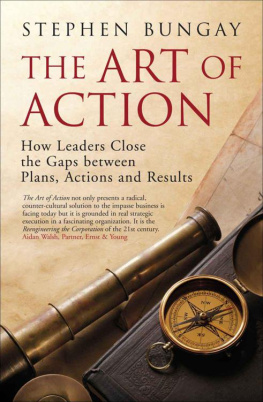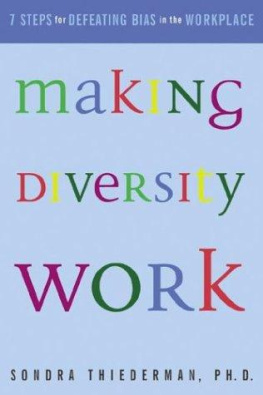Main Idea
Great managers and effective business leaders have an inbuilt bias for action. They dont dissipate their time and energy on peripheral issues like complaining about overwhelming workloads or trying to work despite tight budgets, barriers, setbacks, distractions and unsupportive bosses. Instead, good managers get to work purposefully on the organizations most important work cutting costs, improving efficiency and encouraging innovative thinking and get things done. Good managers harness willpower to improve both their individual performance and that of the organizations they manage. In essence, great managers stop trying to do more things and instead focus on getting the right things done.
The process of becoming a purposeful action taker actually has an organizational and a personal dimension:
Great managers succeed not because they are good at motivating others or giving public addresses, but because they can and do harness personal willpower to achieve their personal goals, and then find ways to help others do the same. The effective application of willpower is what differentiates the achievers from the also-rans.
HEIKE BRUCH is a human resources professor at the University of St. Gallen (Switzerland). She earned her Ph.D. in business administration from the University of Hanover (Germany) and earlier degrees at the Free University of Berlin. Dr. Bruchs research focuses on leadership and she has written six books as well as publishing more than forty articles in journals and books.
SUMANTRAGHOSHAL is a fellow of the Advanced Institute of Management Research as well as a professor of strategy and international management at London Business School. A graduate of MIT and Harvard Business School, Dr. Ghoshal is also a member of the Committee of Overseers of Harvard Business School and founding dean of the Indian School of Business. Dr. Ghoshal has written several books and more than seventy articles which have been published in academic journals.

The organizational dimension of purposeful action-taking
To build an organization that supports and encourages purposeful action-taking, managers and leaders must do three things:
- Create space for autonomous actions to occur, so people have enough freedom to act.
- Build processes which support action taking into the culture of the organization itself.
- Develop a culture which celebrates and encourages purposeful action-taking.
In all, creating an organization that acts purposefully isnt something that can be achieved with quick fixes. Rather, it will require a long journey where the values and benefits of acting purposefully are extolled and then enshrined as worthy of emulation. Embedding a bias for action within an organization is difficult and challenging, but it can and should be done.
While it is true managers must be doers, they cannot achieve their goals in a vacuum. This is why companies and even markets exist. The true challenge for leaders is not to motivate others to act productively but to facilitate purposeful action-taking by the people within their own organization.
How can leaders create an organization that consistently demonstrates a bias for action? In addition to setting a good example, there are three key things leaders can and should do:
1. Overcome the internal challenges
Simply put, this requires that leaders craft a context within the organization that will support and encourage purposeful action-taking. To put this idea into action:
- Give people space their own domain which belongs to them and which they have full control over. Unless people feel like they have this space, they wont self-initiate any purposeful action. The organizations values, vision and beliefs will set logical boundaries but within those areas, people should be able to determine their own actions and standards.
- Support individual actions professionally and personally professional support requires that you ensure each person has a network of experienced people to help them. Personal support means that you do whatever is required to help them cope with stress, overcome any negative feelings and build pride and enthusiasm.
- Embed purposeful management practices into the organizations culture in other words, have managers and leaders who encourage action-taking rather than feeling a need to try and micro manage everything the organization does. If people feel trusted, they will feel confident enough to take the initiative and do more things. Conversely, if everything the organization does suggests that its more important to comply with regulations and rules than to think creatively, thats precisely what everyone will do. Managers set the tone by providing freedom for individuals to act and by shaping the culture. Top management can have a profound impact on the degree to which other managers perceive and exercise their choices.
- Integrate values with daily behaviors so that willpower is always relevant and always at the front of everyones mind.
It may be helpful to try and build some good support networks within your organization to strengthen the organizations bias for action. Support networks may include peers, mentors, experts, consultants, associates in other industries and the organizations leaders. These support networks can function on a formal or informal basis with equal effectiveness.
2. Weave action-taking into the culture
To generate a strong bias for action, your organizations energy must be mobilized and focused effectively. Processes must be built which will encourage and expand the organizational will to get things done. Whenever an organization becomes fully energized around its business goals, people become exhilarated and energized.
In simple terms, the challenge is to move your organization into the productive zone:

- Corporations that have succeeded for long periods sometimes settle into a comfort zone where they lack the vitality and alertness to initiate anything bold and new. As long as the marketplace is stable, they do just fine, but if the marketplace changes as it alwaysdoes then organizations in the comfort zone struggle to adapt.
- Organizations can fall into the resignation zone when theyve been subjected to a number of change initiatives which have failed. Once here, mediocrity becomes accepted as normal and people lose their confidence to deal with new problems.
- Companies in the corrosion zone have energy, activity and emotional commitment, but that intensity is drawn from anger, fear or hate. The organization gets so caught up with internal politics and turf wars there is little vitality or stamina left for productive work. The corrosion zone arises when organizations face an external threat or opportunity that activates energy but there are no internal systems in place to channel that energy in the right direction.
- Organizations in the productive zone have high emotional tension, alertness and activity. Their people are driven by enthusiasm and pride. They have systems in place which allow and encourage people to strive for larger-than-life achievements. These companies live to meet challenges head on and use surprises or the excitement of the unknown to spur people on to exploit novel opportunities and new niches within the marketplace.


















 The organizational dimension of purposeful action-taking
The organizational dimension of purposeful action-taking